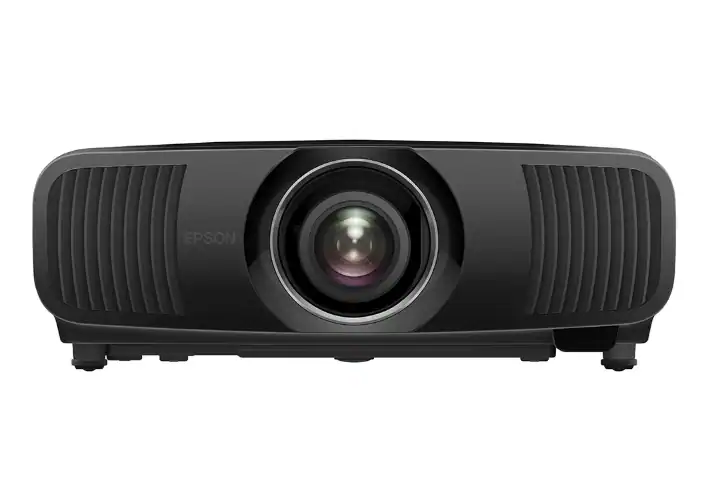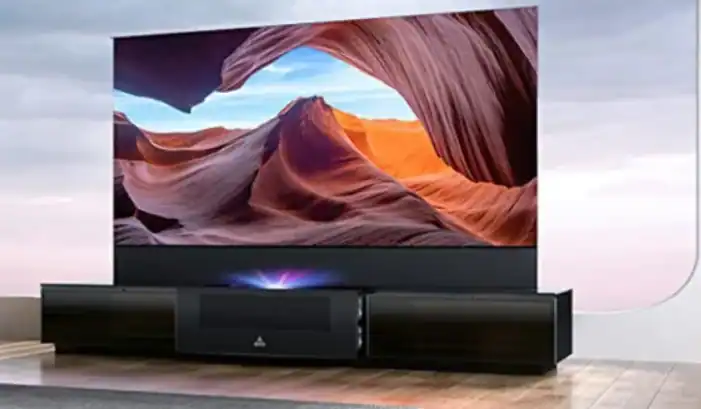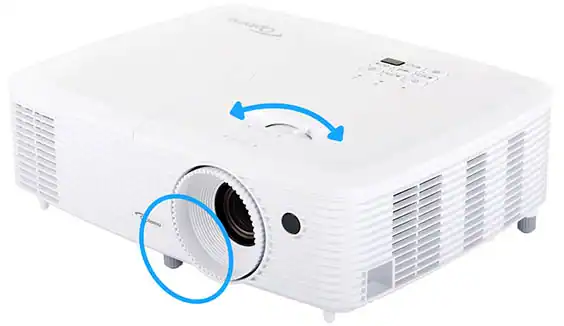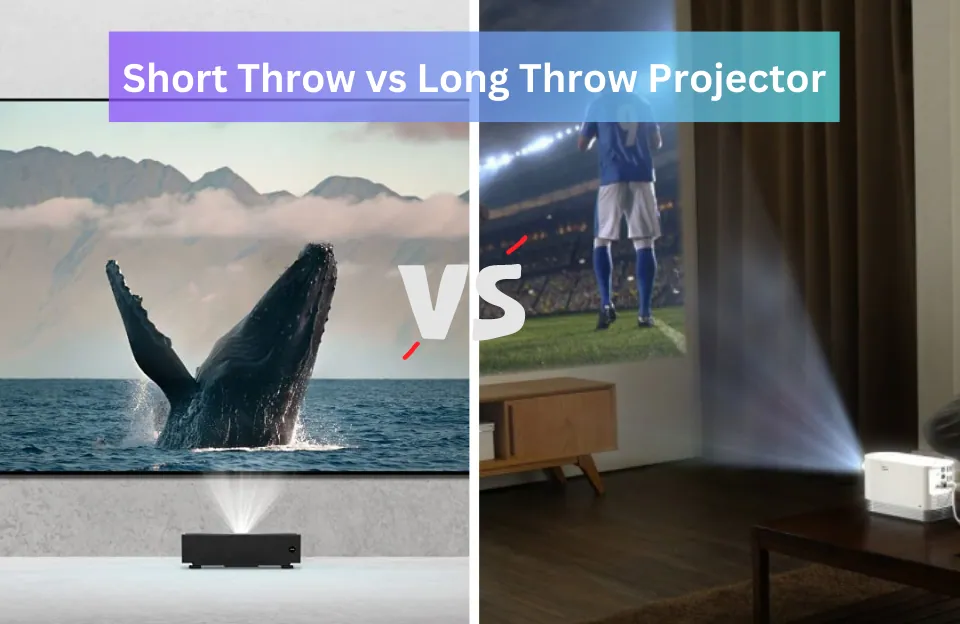Short throw projectors and Long throw projectors are two popular options in the world of projection technology. While both serve the purpose of displaying images and videos on a larger screen, they differ in terms of throw distance, image size, and their suitability for different viewing conditions.
Short throw projectors are designed to project a large image from a close distance, making them ideal for smaller rooms or spaces with limited throw distance. On the other hand, long throw projectors require a significant distance between the projector and the screen to achieve a large image size, making them suitable for larger venues and well-lit environments.
In this comprehensive article, we will explore key differences between short throw and long throw projectors along with their features, and benefits that can definitely help you make an informed decision according to your specific needs.
Understanding Projectors

What is a Projector?
A projector is a device that takes images generated by a computer or Blu-ray player and reproduces them by projection onto a screen, wall, or other surface. Most projectors create an image by shining a light through a small transparent lens, but some newer types of projectors can project the image directly, using lasers.
Types of Projectors
Projectors are primarily categorized based on their throw distance, which is the distance between the projector and the screen. The two main types are short throw and long throw projectors.
What are Short Throw Projectors?
Short throw projectors are designed to project a large image from a relatively close distance to the screen or wall. Unlike traditional projectors that require significant space between the projector and the screen, short throw projectors can be placed just a few feet away. This makes them ideal for smaller rooms or spaces where the available distance for projection is limited.

Short throw projectors typically have a throw ratio of less than 1, meaning they can project a large image even when placed close to the screen.
They use wide-angle lenses and specialized mirror systems to achieve this.
These projectors often come with built-in features like keystone correction and lens shift, allowing for easy image adjustment and alignment.
Benefits and Applications
One of the key benefits of short throw projectors is that they minimize the risk of shadows and obstructions, as the presenter or viewer is less likely to pass between the projector and the screen. This makes them suitable for classrooms, conference rooms, and small home theaters where space is limited.
Short throw projectors also provide a more immersive viewing experience, as they allow for larger image sizes without requiring a significant increase in the projection distance. This is especially advantageous in situations where the room size doesn’t allow for a long throw distance.
What are Long Throw Projectors?
Long throw projectors, as the name suggests, require a significant distance between the projector and the screen to achieve a large image size. They are designed to project images from a distance greater than the screen width, typically with a throw ratio of 1.5 or higher.

Long throw projectors use telephoto lenses that enable them to project images over longer distances while maintaining image clarity and sharpness. These projectors often have a zoom feature, allowing for adjustable image sizes without moving the projector itself.
Benefits and Applications
Long throw projectors are commonly used in large venues such as auditoriums, theaters, and outdoor events where the distance between the projector and the screen is substantial. They are capable of producing larger images with high brightness and clarity, making them suitable for situations where the audience size is significant.

Another advantage of long throw projectors is their ability to project images in well-lit environments. They can handle higher levels of ambient light compared to short throw projectors, ensuring that the projected image remains visible and vibrant even in bright conditions.
Short Throw and Long Throw Projector: Key Differences
The key differences lie in the throw distance, image size, and suitability for different viewing conditions, therefore it’s essential to understand these in detail as it is given below:
Throw Distance and Placement
Short throw projectors require minimal throw distance and can be placed closer to the screen or wall. Long throw projectors, on the other hand, need a substantial throw distance, making them suitable for larger spaces.
Image Size and Clarity
Short throw projectors can produce large images even in close proximity to the screen, but they may sacrifice some image clarity compared to long throw projectors. Long throw projectors can achieve larger image sizes with better clarity and sharpness.
Ambient Light and Viewing Conditions

Short throw projectors are better suited for environments with controlled ambient light or dimly lit rooms. Long throw projectors perform well in well-lit environments and are capable of handling higher levels of ambient light.
It’s important to assess your specific requirements and the characteristics of the space where the projector will be used to determine which type is most suitable.
Installation Flexibility
Short throw projectors are easier to install in small rooms, while long throw projectors offer more flexibility in placement but require more complex installation.
Cost
Short throw projectors can be more affordable, but high-end models may cost as much as long throw projectors. Long throw projectors, especially those with advanced features, tend to be more expensive.
Long Throw Distance vs Short Throw Projector Distance
In order to buy the right projector according to your requirement the most important factor to consider is the throw distance. The throw distance of a projector refers to the distance between the projector and the screen or wall on which the image is projected.
Long throw projectors require a substantial throw distance, meaning they need to be placed further away from the screen or wall to project a large image. These projectors are commonly used in larger venues like auditoriums or outdoor events where the distance between the projector and the screen is significant.
On the other hand, short throw projectors are designed to be placed closer to the screen or wall, requiring minimal throw distance. They are ideal for smaller rooms or spaces with limited space. Short throw projectors offer the advantage of providing larger image sizes even in close proximity to the screen, creating a more immersive viewing experience.
In short, Long throw projectors require a significant throw distance and are ideal for larger venues, while short throw projectors offer larger image sizes in close proximity to the screen. Consider your specific requirements and the characteristics of your viewing space to make an informed decision.
Key Comparison Table
| Feature | Short Throw | Long Throw |
| Placement | Close to the projection screen | Far away from the projection screen |
| Ideal For | Small rooms, home theaters | Large rooms, classrooms, and conference rooms |
| Viewing Distance | Close to the screen | Far from the screen |
| Image Size | Large image in a small space | Large image in a large space |
| Ability to sit close to the screen | Yes | No |
| Brightness | Less bright | Brighter |
| Price | More expensive | Less expensive |
Recommended:
- Best Projector For Projection Mapping
- How Do 3D Projectors Work?
- Best Projector For Daylight Viewing
- Best Projectors Under $500
Applications for Short Throw Projectors
Home Theater
Perfect for small home theaters where space is limited.
Small Meeting Rooms
Ideal for small conference rooms or offices where the projector needs to be close to the screen.
Classrooms
Great for classrooms to avoid shadows and interruptions during presentations.
Applications for Long Throw Projectors
Large Conference Halls
Suitable for large conference halls where the projector needs to cover a vast screen area.
Outdoor Events
Ideal for outdoor movie nights or events, providing large, clear images.
Auditoriums
Perfect for auditoriums and large venues that require high-quality image projection from a distance.
Choosing the Right Projector for Your Needs
The decision between a short throw and a long throw projector ultimately depends on your intended usage and the environment in which it will be used. Here are some considerations to keep in mind:

Considerations for Home Theater Setups:
For home theaters with limited space, a short throw projector can provide an immersive viewing experience without requiring a dedicated room or extensive installation. They are also ideal for gaming setups, as they allow for large, visually engaging displays even in smaller spaces.
Considerations for Educational or Business Environments:
In educational or business settings, short throw projectors are often preferred due to their ability to minimize obstructions caused by presenters and shadows. They can make presentations more engaging and interactive, particularly in classrooms or small meeting rooms.

However, if you are working with a larger venue or require a projector for outdoor events, a long throw projector will be more suitable. Their ability to project larger images over greater distances ensures better visibility for a larger audience.
Popular Short Throw Projector Models:
Popular Long Throw Projector Models:
Key Points to Consider Before Making a Purchase
Here we’ve listed some key points to consider before finalizing your projector purchase, these are as below:
1. Budget and Cost-Effectiveness
Determine your budget and evaluate the cost-effectiveness of short throw and long throw projectors based on your specific requirements.
2. Room Size and Layout

Assess the size and layout of the room or venue where the projector will be used. Consider the available throw distance and whether a short throw or long throw projector can be accommodated.
3. Required Image Size and Resolution
Determine the desired image size and resolution based on your viewing needs. So you will need to consider the seating arrangement plus the distance between the projector and the audience. Then you will get and finalize the required image as per your resolution need.
Related: Different Projector Resolutions Explained
4. Future-Proofing and Upgradeability
Consider the potential for future upgrades and compatibility with emerging technologies. Choose a projector that offers flexibility for future enhancements and updates.
Tips for Setting Up and Optimizing Your Projector
To achieve optimal performance from your projector, follow these tips:
Proper Placement and Alignment
Position the projector at the appropriate distance and angle for your chosen projection size. Ensure that the projector is level and perpendicular to the screen or wall.
Calibration and Image Adjustment

Any projector has some settings that need to be calibrated before using it. These settings are brightness, contrast, and color saturation. Therefore, fine-tune the content on the screen by changing these settings until it meets your preferences.
Ambient Light Control
Minimize ambient light in the room by using curtains or blinds. This will enhance image visibility and reduce glare, especially for short throw projectors.
Related: Lux vs Lumens Projector – How does it affect the Brightness?
Short Throw vs Long Throw Projector: FAQs

What is the ideal throw distance for a short throw projector?
The ideal throw distance for a short throw projector is typically around 1 to 3 feet, depending on the desired image size and the specific model of the projector.
Can a long throw projector be used in a small room?
While it is technically possible to use a long throw projector in a small room, it may not be the most practical choice due to the required throw distance. Short throw projectors are better suited for smaller rooms.
Can I use a short throw projector for gaming?
Absolutely! Short throw projectors are great for gaming setups, as they can provide large and immersive displays even in smaller spaces. They offer a thrilling gaming experience without the need for a dedicated gaming room.
Is it possible to convert a long throw projector into a short throw projector?
Converting a long throw projector into a short throw projector is not a simple task and typically requires specialized optics. It is generally more practical to choose a projector that matches your specific needs from the start.
Is short throw projector better than OLED TV?
Short throw projectors offer the advantage of projecting larger images on a screen or wall, providing a more immersive viewing experience. They are ideal for creating a theater-like atmosphere in smaller rooms or spaces with limited throw distance.
On the other hand, OLED TVs are known for their superior image quality, vibrant colors, and deep blacks. They offer a more traditional TV viewing experience with exceptional picture clarity.
Ultimately, the choice between a short throw projector and an OLED TV will depend on factors such as room size, desired screen size, and your personal preferences for image quality and viewing experience.
Conclusion
To conclude up, the choice between a short throw projector and a long throw projector depends on your specific requirement and the characteristics of your viewing environment. If we talk about Short throw projectors, they offer convenience, space-saving, and an immersive experience in smaller rooms, making them ideal for classrooms, conference rooms, and home theaters with limited space.
On the other hand, long throw projectors excel in larger venues and well-lit environments, providing larger image sizes with better clarity and sharpness. They are suitable for auditoriums, theaters, and outdoor events where the throw distance is substantial.
So, by understanding the differences between them and considering the factors we’ve discussed in this guide you can pick the perfect projector that will deliver optimal performance and enhance your viewing experience. Thank You For Reading!
As an experienced Software Engineer in a Projection-Based Technology Company, I love sharing my Knowledge to utilize and help others to learn more about Projectors. Thus one can get the right Projector for their needs.



